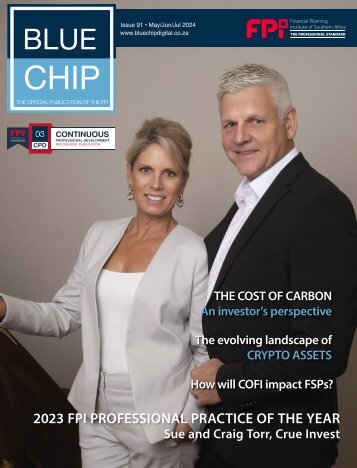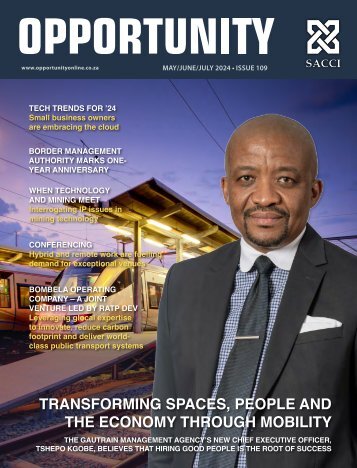South African Business 2016 edition
- Text
- Investment
- Government
- Business
- Development
- Network
- Sectors
- Investing
- Business
- Africa
- African
- Economic
- Manufacturing
- Mining
- Opportunities
- Economy
- Overview
OVERVIEW Regional
OVERVIEW Regional overview: Free State The Free State is one of the nine provinces of South Africa and is centrally located on the flat, boundless plains that dominate the area. It represents 10.6% of the total land area of the country and boasts wide horizons, blue skies, mountains and goldfields. The province covers an area of 129 825 km 2 . The Free State province borders most of the other provinces, with the exceptions being Limpopo and the Western Cape. To the east, it has an international boundary with Lesotho, nestling in the hollow of its beanlike shape, and the escarpment separates it from the Eastern Cape and KwaZulu-Natal. The Orange and Vaal rivers form the southern, western and most of the northern border and the last section of the north-eastern boundary is formed by the Klip River. This centrally located province uses its position to its advantage. The varied economy currently has 3.2-million hectares of cultivated land, although the services sector is the biggest economic contributor. Economy Mining and agriculture were for many decades the bedrock of the Free State economy. The north-western part of the province sits on top of a rich gold-bearing reef more than 400km long, known as the goldfields region. South Africa is the world’s largest gold producer, and the country’s largest gold-mining complex is Free State Consolidated SOUTH AFRICAN BUSINESS 2016 162
Free State sector contribution. SOURCE: FREE STATE DEPARTMENT OF CO-OPERATIVE GOVERNANCE AND TRADITIONAL AFFAIRS. OVERVIEW PERSONAL & GENERAL GOVERNMENT SERVICES 28% FINANCE, REAL ESTATE & BUSINESS SERVICES 20% TRANSPORT, STORAGE & COMMUNICATION 9% WHOLESALE, RETAIL, MOTOR TRADE, CATERING & ACCOMMODATION 11% CONSTRUCTION 2% ELECTRICITY, GAS & WATER 3% MANUFACTURING 14% MINING & QUARRYING 9% AGRICULTURE, FORESTRY & FISHING 4% Goldfields, with an area of 330km 2 . Agriculture Large percentages of South Africa’s agricultural production, particularly grains, originate in the Free State. More than half the nation’s sorghum, nearly half the sunflower and more than 30% of all wheat, maize, potatoes and groundnuts come from the fertile plains of the western and northern Free State, while the valleys of the east produce almost all of South Africa’s cherries and asparagus. Livestock and flowers are other important agricultural products. Services sector Like the rest of the country, the Free State is experiencing considerable growth in the services sector. BPO and call centres are flourishing in the province. Bloemfontein, the main city for economic activity, is at the core for Telkom’s switching centres. Various call centres are located in the city and have created many employment opportunities in the process. The geographical position of the province makes it a key factor for being a transport and logistics hub in South Africa. The resources available for use in the Free State has led to growth in other sectors such as agriculture, manufacturing, mining and tourism. This puts the transport sector in a favourable position. Economic future International investors are focused on South Africa as a buzz has been created around the energy sector. Sasolburg, an important petrochemical site in the Free State, recently fired up a new power plant running solely on gas. This power plant is the largest of its kind in Africa. The plant produces 140MW of power for the usage of Sasol’s chemical factory adjacent to the site, and will also be fed into the national grid. Eskom has a few projects lined up that will feed the national grid. The Ingula scheme, bordering KwaZulu-Natal, has begun construction. Two dams will be connected via underground turbines just short of five kilometres long. The project will eventually deliver 1 332MW of hydroelectricity. Eskom has set aside R300-billion for infrastructure development across the country for the next years to 2018. Of that amount, Ingula has used 58% of the allocated R25.9-billion. FREE STATE www.freestateonline.fs.gov.za Capital Population Area Premier Bloemfontein 2 817 900 (2015) 129 825 km 2 Ace Magashule (ANC) Languages Afrikaans, English, Sotho, Tswana 163 SOUTH AFRICAN BUSINESS 2016
- Page 1:
SOUTH AFRICAN BUSINESS 2016 EDITION
- Page 6:
CONTENTS Introduction CONTENTS Sout
- Page 10 and 11:
CREDITS Publisher Chris Whales Publ
- Page 12 and 13:
SPECIAL FEATURE South Africa A peri
- Page 14 and 15:
SPECIAL FEATURE In a year that saw
- Page 16 and 17:
SPECIAL FEATURE owes its existence
- Page 18 and 19:
SPECIAL FEATURE against water losse
- Page 20 and 21:
SPECIAL FEATURE Operation Phakisa h
- Page 22 and 23:
SPECIAL FEATURE late in 2014. The h
- Page 24 and 25:
SPECIAL FEATURE Understanding Afric
- Page 26 and 27:
INTERVIEW Job creation on track Ala
- Page 28 and 29:
SPECIAL FEATURE Business funding Th
- Page 30 and 31:
SPECIAL FEATURE in turn makes it ve
- Page 32 and 33:
SPECIAL FEATURE Contact: 012 394 18
- Page 34 and 35:
SPECIAL FEATURE Black Business Supp
- Page 36 and 37:
SPECIAL FEATURE The evolution of sk
- Page 38:
SPECIAL FEATURE providing TVET lear
- Page 42:
PROFILE FP&M Seta Facilitating and
- Page 45 and 46:
• The development of a national s
- Page 48 and 49:
FOCUS Champions of change Five dyna
- Page 50 and 51:
SPECIAL FEATURE The top law firms S
- Page 52 and 53:
SPECIAL FEATURE Keeping the BRICS t
- Page 54 and 55:
SPECIAL FEATURE Keeping BEPS in che
- Page 56 and 57:
SPECIAL FEATURE IPAP in action In 2
- Page 58 and 59:
FOCUS THERE’S NO END TO THE BENEF
- Page 60 and 61:
INTERVIEW The riches of Africa awai
- Page 62 and 63:
INTERVIEW and it could actually be
- Page 64 and 65:
PROFILE ECIC exco profiles Profiles
- Page 66 and 67:
INTERVIEW The hub of Africa Tim Har
- Page 69 and 70:
Key sectors Overview of the main ec
- Page 71 and 72:
OVERVIEW from the subsistence farme
- Page 73 and 74:
OVERVIEW South Africa produces abou
- Page 75 and 76:
South Africa’s looming energy gap
- Page 77 and 78:
How will these resources be develop
- Page 79 and 80:
Vall exclusive economic zone limits
- Page 82 and 83:
OVERVIEW NEED PIC Mining The South
- Page 84 and 85:
OVERVIEW Mineral beneficiation The
- Page 86 and 87:
PROFILE The Council for Geoscience
- Page 88 and 89:
OVERVIEW Energy The South African e
- Page 90 and 91:
INTERVIEW Cummins South Africa Cumm
- Page 92 and 93:
OVERVIEW Manufacturing Increasing m
- Page 94 and 95:
OVERVIEW Automotive International i
- Page 96 and 97:
OVERVIEW Automotive components Incu
- Page 98 and 99:
OVERVIEW Chemicals and pharmaceutic
- Page 100 and 101:
OVERVIEW Healthcare South Africa’
- Page 102 and 103:
OVERVIEW Water Severe water restric
- Page 104:
OVERVIEW Improving quality The intr
- Page 107 and 108:
Our Vision is is “Quality water f
- Page 109 and 110:
OVERVIEW 107 SOUTH AFRICAN BUSINESS
- Page 111 and 112:
OVERVIEW airports in India and Braz
- Page 113 and 114: affords, while maintaining its envi
- Page 115 and 116: kets, except Australia. In Africa,
- Page 117 and 118: Rosebank, Johannesburg, renamed ‘
- Page 119 and 120: Trade with Africa Improved infrastr
- Page 121 and 122: FOCUS MTN plugs R1.2-billion into K
- Page 123 and 124: MTN rolls out fibre infrastructure
- Page 125 and 126: OVERVIEW community engagement. The
- Page 127 and 128: PROFILE For BEE Verification and is
- Page 129 and 130: OVERVIEW attracting and retaining c
- Page 131 and 132: OVERVIEW Small business is taken ve
- Page 133 and 134: Franchise Fund—an innovative plat
- Page 135 and 136: educating young people in fields th
- Page 137 and 138: OVERVIEW Management Plan has divert
- Page 139 and 140: hazardous waste is also not being c
- Page 141 and 142: INTERVIEW yourself up as a Tier 1 o
- Page 144 and 145: OVERVIEW Renewable energy South Afr
- Page 146 and 147: INTERVIEW Plenty of scope for solar
- Page 148 and 149: LISTINGS South African business org
- Page 150 and 151: LISTINGS South African National Gov
- Page 152 and 153: LISTINGS Department of Communicatio
- Page 154 and 155: LISTINGS Department of Human Settle
- Page 156 and 157: LISTINGS Department of Science and
- Page 158 and 159: OVERVIEW Regional overview: Eastern
- Page 162 and 163: INTERVIEW Buffalo City on the rise
- Page 166 and 167: OVERVIEW Regional overview: Gauteng
- Page 168 and 169: FOCUS A Catalyst for Economic Devel
- Page 170 and 171: FOCUS business people and tourists
- Page 172 and 173: OVERVIEW Regional overview: KwaZulu
- Page 174 and 175: OVERVIEW Regional overview: Limpopo
- Page 176 and 177: OVERVIEW Regional overview: Mpumala
- Page 178 and 179: The powerhouse of Africa Mpumalanga
- Page 180 and 181: Mpumalanga: Key Sectors Mpumalanga
- Page 182 and 183: Nkomazi Special Economic Zone The N
- Page 184 and 185: INVEST IN THE PROVINCE OF THE RISIN
- Page 186 and 187: OVERVIEW Regional overview: Norther
- Page 188 and 189: OVERVIEW Regional overview: North W
- Page 190 and 191: OVERVIEW Regional overview: Western
- Page 192 and 193: FOCUS Khayelitsha - the power of to
- Page 194 and 195: INDEX INDEX Abeco Tanks ...........
- Page 196: ENSafrica.com ENSafrica | Africa’
Inappropriate
Loading...
Mail this publication
Loading...
Embed
Loading...























































































































































